I’m sure all of you have seen “The Christmas Story”, with Darren MacGavin. You’ve seen it. I lived it.
I was raised in Texas, so of course I had cap pistols. But no caps. Well, I had no caps, officially. Mother could see me playing cowboys and Indians and having a cap gun, but certainly no caps. Caps exploded and things that explode can damage a young boy. But occasionally, someone would give me a roll of caps and I could shoot the bad guys and give it the proper bang! so the guy would know he was dead. But such battles were not fought at 1823 Maryland. No siree. Around the corner on Marsalis, at the home court of Jimmy McVey. His mother had no problem with exploding things. And in spite of that, Jimmy lived to be an adult with both eyes.
A BB gun was an entirely different matter. Those were not allowed around, with or without BBs.
You guessed it. A BB gun would shoot your eye out. Without question. Guaranteed. Now, this only came from my Mother. My Father, raised in southwest Texas, on the frontier, so to speak, and spending lots of time on the ranch of his cousins, understood the value of guns. We never had one in the house. But they had them on the ranches my Father roamed. And, he had both his eyes. He did wear glasses, but I am convinced that was not a result from an errant BB.
But Mother was definitely a city girl. Wise in the ways of urban living. And she understood BB guns. They would put your eye out as certainly as milk came out of a bottle.
So my formative years were formed without the benefit of a BB gun. Imagine my excitement when several of my grade school buddies divided into two warring teams, ready to do battle with honest-to-goodness BB guns – AND, they provided me with a trusty Roy Rogers rifle, capable of holding fifty BBs, and shooting an opponent fifty yards away. Well, fifty feet anyway.
Needless to say, I could hear my Mother’s constant warning about the dangers of such weapons. But we were at John Hope’s house, far from my Mother.
The game was afoot.
John Hope lived across the street from an immense protestant church that rambled over most of a block, with buildings here and there, bushes, trees, walls, crannies and nooks, hiding places galore. This would be a long and glorious fight and surely my team would win. Before long, I spied one of the enemy, moving stealthily to my right. I lined up a perfect shot and prepared to shoot him in the heart.
Suddenly, before I managed to squeeze off my first round, I am in great pain. I had been shot! Directly and squarely between the eyes!
I crouched down, reverently laid down the Roy Rogers rifle and felt just above my nose, just between my eyes. There was a small, neat dent, and it burned like fire. And my ears rang loud with my Mother’s voice. “You’ll get an eye shot out.”
My God. She was right. As if a sign from God, the first incident of my first BB gun fight had been a shot between my eyes. A half inch right or left and I would have lost an eye. She knew. My Mother knew, the way mothers everywhere know. She knew with that perfect vision mothers have that I was not meant to play with BB guns. Now, I knew.
Carefully, I picked up the trusty Roy Rogers rifle, turned and walked across the street to John Hope’s house. I laid the shiny, superb piece of craftsmanship down on John’s porch and started walking the nine blocks back to my house. I rubbed the small dent between my eyes, willing it to smooth out so mother would not notice. It didn’t. It stayed there for years, a constant reminder of the wisdom of mothers and the foolishness of young boys. My Mother never commented on it, though I am certain she noticed, certain she knew how that dent came about.
Never again did I ask for a BB gun for Christmas or birthday. Mother was right. Maybe if I had been raised on a ranch, or on the frontier of 1910 southwest Texas. But I was a city boy, who had a great desire to keep both his eyes.

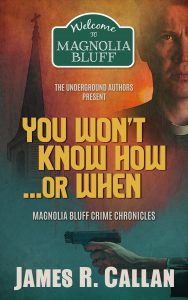
 Her Mrs. Odboddy series covers mysterious happenings during World War II and features a whacky, older woman who manages to get involved in strange things. Much of her incidents have a basis in fact. I’ll let her tell you about that. Elaine is a member of Sisters in Crime, Northern CA Publishers and Authors, and Cat Writers Association.
Her Mrs. Odboddy series covers mysterious happenings during World War II and features a whacky, older woman who manages to get involved in strange things. Much of her incidents have a basis in fact. I’ll let her tell you about that. Elaine is a member of Sisters in Crime, Northern CA Publishers and Authors, and Cat Writers Association.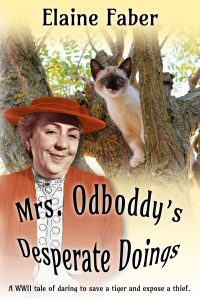 When she falls from a tree and suffers a head injury, her usual eccentric notions increase. But when she adamantly accuses the local doctor of stealing a well-known War Artist’s painting, and The Lord’s Shepherd lithograph from the church, folks wonder if her head injury is responsible for increasingly irrational behavior, or is it dementia? For a raucous adventure with an absurdly funny elderly sleuth, you can’t miss with Mrs. Odboddy’s Desperate Doings.
When she falls from a tree and suffers a head injury, her usual eccentric notions increase. But when she adamantly accuses the local doctor of stealing a well-known War Artist’s painting, and The Lord’s Shepherd lithograph from the church, folks wonder if her head injury is responsible for increasingly irrational behavior, or is it dementia? For a raucous adventure with an absurdly funny elderly sleuth, you can’t miss with Mrs. Odboddy’s Desperate Doings.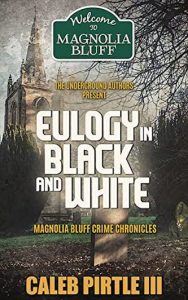 As the date comes closer and closer, there is mounting tension in Magnolia Bluff. Most citizens don’t talk about it. But it’s on their minds, everyone’s. A school principal, a judge, an Army recruiter, the publisher of the local newspaper, a coach, a small-time crook, and others. No real connection. Each murder different. Each corpse dealt with differently. Each detail different.
As the date comes closer and closer, there is mounting tension in Magnolia Bluff. Most citizens don’t talk about it. But it’s on their minds, everyone’s. A school principal, a judge, an Army recruiter, the publisher of the local newspaper, a coach, a small-time crook, and others. No real connection. Each murder different. Each corpse dealt with differently. Each detail different.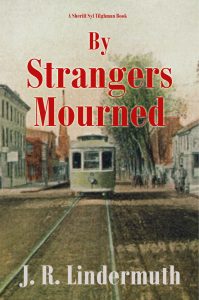 I was aware mine operators in Pennsylvania’s anthracite coal region utilized agencies to recruit labor in eastern Europe in the 19th Century. This was not an altruistic attempt to help the poor but rather a means of finding cheap labor to compete with the rise of unions on the domestic scene. When I discovered these same agencies were also used to recruit women to work in other industries it planted the germ of the story that became By Strangers Mourned.
I was aware mine operators in Pennsylvania’s anthracite coal region utilized agencies to recruit labor in eastern Europe in the 19th Century. This was not an altruistic attempt to help the poor but rather a means of finding cheap labor to compete with the rise of unions on the domestic scene. When I discovered these same agencies were also used to recruit women to work in other industries it planted the germ of the story that became By Strangers Mourned.
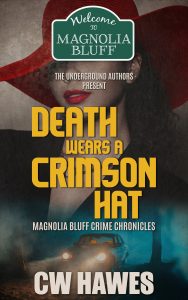 a good mystery and great characters, grab a copy of
a good mystery and great characters, grab a copy of